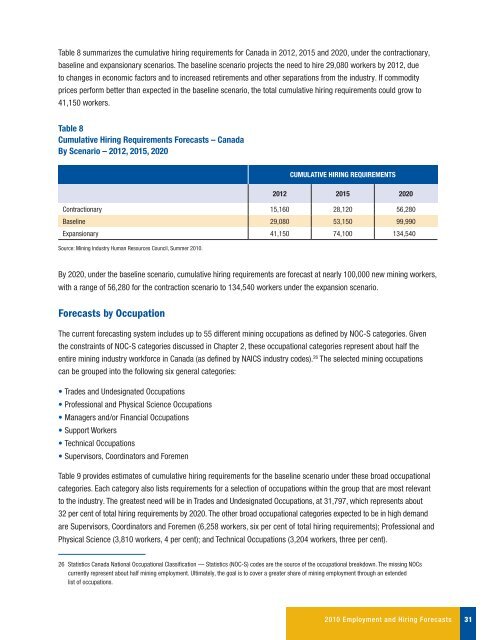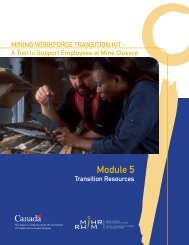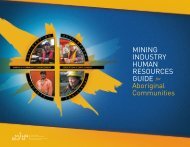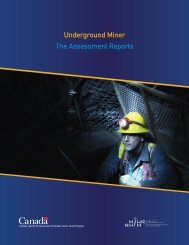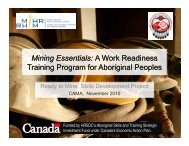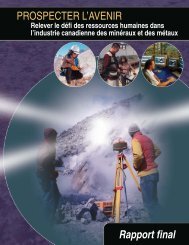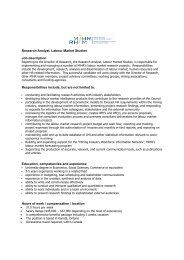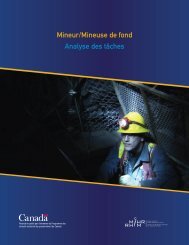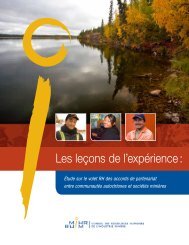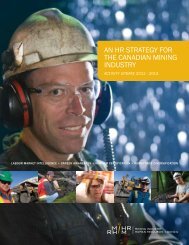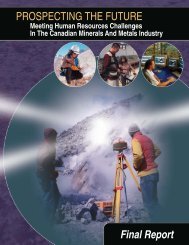Canadian Mining Industry Employment and Hiring Forecasts - MiHR
Canadian Mining Industry Employment and Hiring Forecasts - MiHR
Canadian Mining Industry Employment and Hiring Forecasts - MiHR
Create successful ePaper yourself
Turn your PDF publications into a flip-book with our unique Google optimized e-Paper software.
Table 8 summarizes the cumulative hiring requirements for Canada in 2012, 2015 <strong>and</strong> 2020, under the contractionary,<br />
baseline <strong>and</strong> expansionary scenarios. The baseline scenario projects the need to hire 29,080 workers by 2012, due<br />
to changes in economic factors <strong>and</strong> to increased retirements <strong>and</strong> other separations from the industry. If commodity<br />
prices perform better than expected in the baseline scenario, the total cumulative hiring requirements could grow to<br />
41,150 workers.<br />
Table 8<br />
Cumulative <strong>Hiring</strong> Requirements <strong>Forecasts</strong> – Canada<br />
By Scenario – 2012, 2015, 2020<br />
Cumulative <strong>Hiring</strong> Requirements<br />
2012 2015 2020<br />
Contractionary 15,160 28,120 56,280<br />
Baseline 29,080 53,150 99,990<br />
Expansionary 41,150 74,100 134,540<br />
Source: <strong>Mining</strong> <strong>Industry</strong> Human Resources Council, Summer 2010.<br />
By 2020, under the baseline scenario, cumulative hiring requirements are forecast at nearly 100,000 new mining workers,<br />
with a range of 56,280 for the contraction scenario to 134,540 workers under the expansion scenario.<br />
<strong>Forecasts</strong> by Occupation<br />
The current forecasting system includes up to 55 different mining occupations as defined by NOC-S categories. Given<br />
the constraints of NOC-S categories discussed in Chapter 2, these occupational categories represent about half the<br />
entire mining industry workforce in Canada (as defined by NAICS industry codes). 26 The selected mining occupations<br />
can be grouped into the following six general categories:<br />
• Trades <strong>and</strong> Undesignated Occupations<br />
• Professional <strong>and</strong> Physical Science Occupations<br />
• Managers <strong>and</strong>/or Financial Occupations<br />
• Support Workers<br />
• Technical Occupations<br />
• Supervisors, Coordinators <strong>and</strong> Foremen<br />
Table 9 provides estimates of cumulative hiring requirements for the baseline scenario under these broad occupational<br />
categories. Each category also lists requirements for a selection of occupations within the group that are most relevant<br />
to the industry. The greatest need will be in Trades <strong>and</strong> Undesignated Occupations, at 31,797, which represents about<br />
32 per cent of total hiring requirements by 2020. The other broad occupational categories expected to be in high dem<strong>and</strong><br />
are Supervisors, Coordinators <strong>and</strong> Foremen (6,258 workers, six per cent of total hiring requirements); Professional <strong>and</strong><br />
Physical Science (3,810 workers, 4 per cent); <strong>and</strong> Technical Occupations (3,204 workers, three per cent).<br />
26 Statistics Canada National Occupational Classification — Statistics (NOC-S) codes are the source of the occupational breakdown. The missing NOCs<br />
currently represent about half mining employment. Ultimately, the goal is to cover a greater share of mining employment through an extended<br />
list of occupations.<br />
2010 <strong>Employment</strong> <strong>and</strong> <strong>Hiring</strong> <strong>Forecasts</strong><br />
31


